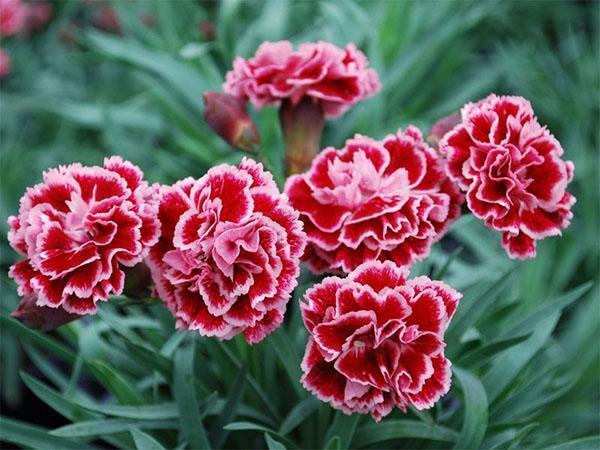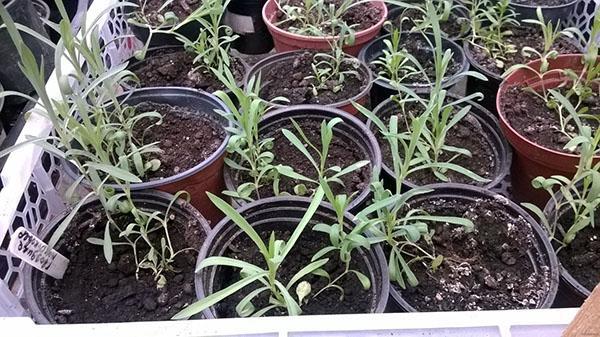Easy care for your garden carnation
 Many gardeners love to grow beautiful carnation flowers on their plots. Their refined and bright beauty catches the eye, carnations are a real decoration of the flower bed. But it is also an unpretentious and not very capricious flower. Caring for your garden carnation is pleasant and uncomplicated. It is enough to know the main principles of growing a flower beauty.
Many gardeners love to grow beautiful carnation flowers on their plots. Their refined and bright beauty catches the eye, carnations are a real decoration of the flower bed. But it is also an unpretentious and not very capricious flower. Caring for your garden carnation is pleasant and uncomplicated. It is enough to know the main principles of growing a flower beauty.
How to grow a flower

A perennial carnation in the garden grows well on light soil with neutral acidity, saturated with humus and sand. The soil for it should be water-permeable and not waterlogged.
The plant is planted at a temperature of + 15 ° C. Clove seeds are sown into a substrate of humus, sand, sod land in equal parts and lightly sprinkled. A very important question for a gardener is how to plant a carnation correctly. The soil must be moist. They cover it to retain heat and moisture. After germination, it is no longer necessary to cover the sowing.  When the leaves appear, they carry out a pick into separate containers and top dressing mineral fertilizers... The grown carnation seedlings are planted on the flower bed, maintaining a distance of 20 cm, the soil is mulched. Planting garden carnations in compliance with agricultural technology and further care help to grow gorgeous flowers.
When the leaves appear, they carry out a pick into separate containers and top dressing mineral fertilizers... The grown carnation seedlings are planted on the flower bed, maintaining a distance of 20 cm, the soil is mulched. Planting garden carnations in compliance with agricultural technology and further care help to grow gorgeous flowers.
Garden carnation care
 Flowers in flower beds require some attention during growth. A few simple rules provide the most favorable conditions for carnations:
Flowers in flower beds require some attention during growth. A few simple rules provide the most favorable conditions for carnations:
- weed removal;
- pinching a flower;
- frequent watering;
- loosening the soil;
- plant feeding;
- garter.
Carnation does not like the neighborhood of weeds and herbs, the flower must be freed from them. The abundance of weeds around the flower slows down or completely inhibits its growth. Weeding is an indispensable element of caring for a fragile beauty.
 Caring for a garden perennial carnation also consists in pinching the top of the flower, which gives an impetus to the rapid flowering. The plant begins to bush and give lateral shoots. The pinching is carried out above the upper leaf node, with a stem height of 15 cm. How is a carnation pinched? Do it with your fingers. After a month, the pinching is repeated.
Caring for a garden perennial carnation also consists in pinching the top of the flower, which gives an impetus to the rapid flowering. The plant begins to bush and give lateral shoots. The pinching is carried out above the upper leaf node, with a stem height of 15 cm. How is a carnation pinched? Do it with your fingers. After a month, the pinching is repeated.
We must not forget about moistening and nourishing the soil where perennial plants are planted. Street carnation needs care associated with moderate watering, after which the soil is necessarily loosened.
Do not allow the soil to become waterlogged next to the carnation bushes, this can lead to root rot.
Organic and especially mineral fertilizers are applied to the soil, this contributes to the good development of the stems and vigorous flowering. It is important to feed the plant with complex fertilizers when the buds appear.
 If the stems of a carnation grow very tall, the plant is tied up. It should be upright, otherwise the stems will break under the weight of the flowers. The stems are tied to the supports with twine or nylon thread. This should be done very carefully and not tight.
If the stems of a carnation grow very tall, the plant is tied up. It should be upright, otherwise the stems will break under the weight of the flowers. The stems are tied to the supports with twine or nylon thread. This should be done very carefully and not tight.
When the flowers of the carnations wilt, they must be cut off immediately. This stimulates new flowering.
Garden carnations need to be prepared for winter. Frost should not damage her. To do this, trim the wilted flower above the soil. Be sure to mulch the soil around the plant. This will help the roots get a supply of nutrients.Some gardeners in regions with cold winters dig up flower bushes, transplant them into boxes, containers, or pots and bring it into the house for the winter. In this case, the carnation will overwinter safely.
The flower beds bloom all summer long if you remember these simple rules on how to grow a perennial carnation.
How carnations reproduce
 There are several ways to reproduce this perennial flower:
There are several ways to reproduce this perennial flower:
- layering;
- cuttings;
- dividing the bush.
Layers are created with damp earth and a cut in the stem. Long side shoots are cut from below, fixed, sprinkled with soil and watered. Soon roots appear, a green sprout sprouts. It is separated from the carnation bush and planted in the ground.
Sometimes layering is obtained from a lush bush with side branches, sprinkling them with earth. At the same time, they are regularly watered. After a while, the twigs take root. Then they are transplanted separately.
 Reproduction of any type of carnation by cuttings is very popular among gardeners. This is usually done in early June. At the carnation bush, long lateral shoots are chosen with at least four leaves. The shoots are freed from the leaves, several cuts are made between the nodes on the stem. It is helpful to dip the slices into a growth promoter. Cuttings are planted in a substrate prepared in half from fertile soil and humus, adding a little sand there. The planted cuttings are covered with transparent material to create a kind of greenhouse. They take root in three weeks, give shoots.
Reproduction of any type of carnation by cuttings is very popular among gardeners. This is usually done in early June. At the carnation bush, long lateral shoots are chosen with at least four leaves. The shoots are freed from the leaves, several cuts are made between the nodes on the stem. It is helpful to dip the slices into a growth promoter. Cuttings are planted in a substrate prepared in half from fertile soil and humus, adding a little sand there. The planted cuttings are covered with transparent material to create a kind of greenhouse. They take root in three weeks, give shoots. Full bloom of a new clove bush can be expected in a year.
Full bloom of a new clove bush can be expected in a year.
 In early spring, carnations can be propagated by dividing the bush. The plant is completely dug up and the root is divided into several separate bushes. Each of them must have a healthy and developed root, a large lateral shoot. The resulting young bushes are planted in the ground. They are looked after as for an adult plant. Flowering will begin next year.
In early spring, carnations can be propagated by dividing the bush. The plant is completely dug up and the root is divided into several separate bushes. Each of them must have a healthy and developed root, a large lateral shoot. The resulting young bushes are planted in the ground. They are looked after as for an adult plant. Flowering will begin next year.
Clove diseases
 Caring for and caring for a garden carnation includes the mandatory prevention of diseases and getting rid of plant pests.
Caring for and caring for a garden carnation includes the mandatory prevention of diseases and getting rid of plant pests.
Unfortunately, carnation, like other flowers, is susceptible to several diseases:
- fungus;
- gray rot;
- rust;
- rhizoctonia;
- fusarium.
The heterosporium fungus infects cloves with an excess of moisture and nitrogenous fertilizers in the soil. Brown spots with reddish rims appear on the leaves of the plant. The plant begins to dry out and dies. In this case, the affected plants are burned, the soil is treated with Bordeaux liquid. To prevent this disease, the bushes are treated with Nitrafen or other similar drugs twice a season.
Gray rot - Botrytis appears on flowers during the period of prolonged rains, cooling, in the absence of sunlight. Sometimes the disease is provoked by a large excessive density of planted plants. They are covered with a gray smoky coating. Such flowers must be destroyed. Prevention: avoid excessive moisture and spray with fungicides.
Treatment with fungicidal preparations should not be carried out on sunny days with strong winds. The optimal conditions for this are dry and cloudy weather.
Fungus also causes rust. In this case, the stems, leaves are affected, they turn yellow and dry out. The disease provokes a lack of potassium in the soil and an excess of nitrogen, excessive waterlogging. The affected plants are removed, sprayed with fungicides, for example, Bordeaux liquid. Prevention consists in moderate watering, weeding of weeds - carriers of pathogens.
Rhizoctonia leads to decay of the root system of the clove at the root collar. The plant stops receiving nutrients. Its leaves turn yellow, wither, the roots are affected by rot. A versatile and effective fungicide - the drug "Maxim", is suitable for saving plants. For prevention, constant loosening of the soil and moderate watering are necessary.
Fusarium wilting - staining of the stem reddish, yellowing leaves, decay of roots. As a result, the flowers stop blooming, the plant dies. Too much humidity, acidic soil and hot weather can become the cause of the manifestation of the disease. It is impossible to cure such plants; they are dug up and burned. Protect the carnation from this scourge by mulching and moderate watering.
Garden beauty pests
 Sometimes it is difficult to avoid an attack on a carnation flower of such pests:
Sometimes it is difficult to avoid an attack on a carnation flower of such pests:
- nematodes;
- caterpillars;
- thrips.
Gallic nematodes are small worms dangerous for the plant. They grow on the roots of carnations in high humidity in hot weather. Nematodes are real parasites that form growths and absorb nutrients, liquid from the roots. In this case, the leaves of the carnation turn yellow, and the plant dies. There is a variety of stem nematodes that live inside the plant. Nematodes infest the soil around the flower. The fight against the pest consists in the introduction of nematicides and formalin.
Caterpillars attack the plant, crawling out of the soil, they damage buds and leaves. For prevention, in the spring, clove bushes are treated with dichlorophos or similar preparations. The soil is pollinated with antiparasitic agents.
Thrips affect cloves, leaving whitish spots on the plant. The plant withers and dies. Such bushes are destroyed, and the soil is disinfected, and they are treated several times.
Good care of a gorgeous flower - a garden carnation will allow you to admire its beauty until the fall.